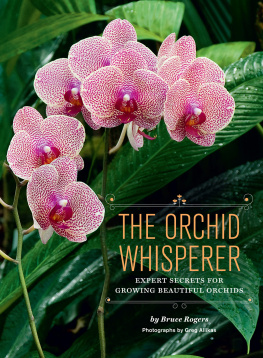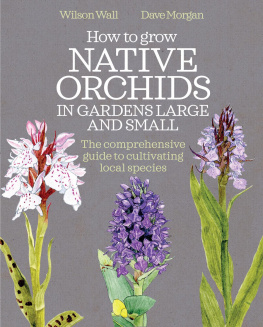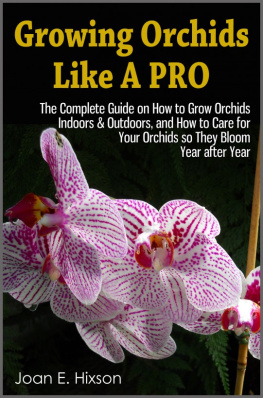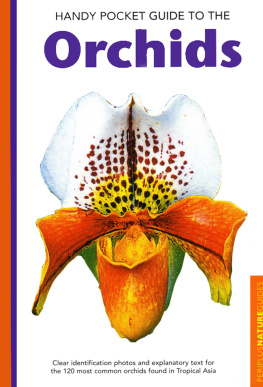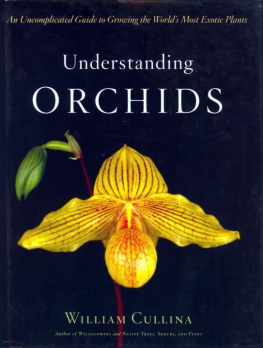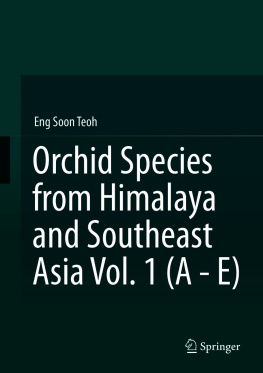VANILLA ORCHIDS

VANILLA ORCHIDS
Natural History and Cultivation
KEN CAMERON

Frontispiece: Vanilla planifolia from Kohlers 1887 series on medicinal plants.
Copyright 2011 by Ken Cameron. All rights reserved.
Photographs are by the author unless otherwise indicated.
Published in 2011 by Timber Press, Inc.
The Haseltine Building
133 S.W. Second Avenue, Suite 450
Portland, Oregon 97204-3527
www.timberpress.com
2 The Quadrant
135 Salusbury Road
London NW6 6RJ
www.timberpress.co.uk
Printed in China
Text designed by Susan Applegate
Library of Congress Cataloging-in-Publication Data
Cameron, Kenneth Michael.
Vanilla orchids: natural history and cultivation/Ken Cameron.1st ed.
p. cm.
Includes bibliographical references and index.
ISBN-13: 978-0-88192-989-8
1. Vanilla. 2. Orchids. 3. Vanilla industry. I. Title.
SB307.V2C25 2011
633.82dc22 2010048813
A catalog record for this book is also available from the British Library.
Contents
What frightful trouble you have taken about Vanilla: you really must not take an atom more; for the orchids are more play than real work.
CHARLES DARWIN
to Sir Joseph Hooker
August 30, 1861
INTRODUCTION
Vanilla as Flavor and Fragrance
THE WORD vanilla has become synonymous with plain, boring, white, common, ordinary, and flavorless. Vanilla, however, is one of the most exotic, rare, expensive, intense, and popular of all flavors and fragrances. Why the dichotomy between perception and reality? Perhaps it is due to a fundamental lack of understanding about this spice. When asked about the source of vanilla extract, most people say that vanilla is derived from a kind of bean. Few understand that vanilla beans are actually the fruits of orchids of the genus Vanilla (PLATES 1 3). This information usually elicits quizzical looks. Suddenly it makes sense why that little bottle of extract is so expensive.
True beans are members of the pea family (Leguminosae or Fabaceae). These plants all share a common fruit type known as a legume, which is a pod composed of a single chamber containing several seeds attached to one side of the fruit wall and that splits open along one side when dry at maturity. A bean is the product of pollination of a flower with a superior ovary. A great many legumes are agriculturally important, primarily for their seeds (such as soybeans, black-eyed peas, chickpeas), sometimes for their fruits (green beans and snow peas), and occasionally for their leaves (alfalfa), flowers and nectar (indigo, clover), or wood (locust). They are rarely used as a spice.
If you find it difficult to believe that vanilla is the worlds most popular spice, take an inventory of your own home. Start in the kitchen. Nearly all of the ice creams in your freezer and soft drinks in the refrigerator will contain some vanilla flavor, as will some yogurts, salad dressings, syrups, and breakfast cereals. With the exception of raw baking chocolate, anything with chocolate flavoring most likely also contains vanilla (PLATES 4, 5). People have tamed the bitter taste of chocolate with vanilla for a very long time. A great many household cleaners, detergents, and fabric softeners contain vanilla fragrance even if they are advertised as being of a different scent. This is because vanilla has a special ability to link different aromas together, to soften them, and to carry them for a longer time. Now on to the bathroom, where your shaving cream, shampoos, hair conditioners, lotions, soaps, bath salts, colognes, and perfumes likely contain vanilla fragrance as well. Somewhere along the way, in the bedroom perhaps, you may have walked past a vanilla-scented air freshener, scented candle, or dish of potpourri (PLATE 6). Few other spices are used so regularly as both flavor and fragrance in the home. Vanilla is a popular natural product.
Vanilla continues to lead among all other flavors of ice cream. In the United States alone, vanilla ice cream accounts for more than one-third of the 1.25 billion ice cream products sold each year. This is a market worth more than $20 billion, and it translates into 22 L (5.8 gal) of ice cream per American per year. The figures are smaller in Europe, but vanilla ice cream reigns supreme there as well. Tim Ecott, in his book Vanilla: Travels in Search of the Ice Cream Orchid (2004), noted that although the British only consume 8 L (2 gal) of ice cream per year, they choose vanilla 90 percent of the time. This worldwide level of popularity, in fact, continues to rise as luxuries from the West, including ice cream, become more prevalent in China and other developing parts of Asia. These cultures traditionally have not incorporated vanilla into their cuisine. But today one is just as likely to see a young Chinese person drinking a vanilla-laced cola and enjoying a vanilla ice cream cone as one would an American teenager. The demand for high-quality, natural vanilla flavor is growing.
The demand for vanilla as a fragrance is also high and best exemplified by the womens perfume and cosmetics industry (PLATE 7). Each year new perfumes are introduced on the world market. Some of these, such as Chanel No. 5 and Shalimar, become classics, whereas others may remain in vogue for only a short time. Each is a subtle and proprietary blend of fragrances known only to the perfumier. What they all have in common, however, is a shared orchestration. Fine perfumes first release top notes that are volatile, sharp, and distinctive but short-lived. As the primary scent dissipates, it is followed for several hours by secondary notes that are unmasked gradually throughout the day as the warm skin increases their volatility. By the time that evenings hour of romance arrives, the top and middle notes have vanished, and only the longest lasting, most sensuous base notes of the perfume remain. More than any other fragrance, vanilla serves this final purpose. The human nose is capable of detecting the vanillin molecule in unbelievably small quantities and for a very long time. Whereas some perfumes may contain lemon, orange blossom, lavender, musk, or cloves, nearly all of them contain vanilla. So important is highly concentrated natural vanilla extract to the high-end perfume industry that buyers are willing to pay as much as $5000 per kilogram to concoct their finest blends.
A friend once told the story of being in a fine restaurant and asking the waiter what flavors of ice cream they had for dessert. The waiter replied, We dont have any flavors, just vanilla. Perhaps this view of vanilla as flavorless is due to its ubiquity and should be considered a compliment. Most of us do not fully appreciate the importance that natural and even artificial vanilla has in our daily lives, and we are certainly ignorant about the history and biology of this orchid genus (PLATE 8).
The intention of this book is to present Vanilla and its closest relatives in a new light. Several wonderful books have been published on the history of Vanilla domestication and its importance to human cultures (PLATE 9). Others have focused on the economics of the vanilla industry. Some technical books have been published primarily for Vanilla farmers and processors, and there are even cookbooks dedicated solely to the use of vanilla as a flavoring. This book touches on each of those topics, while also considering in greater detail Vanilla, the orchid. This genus and its relatives (other genera of vanilloid orchids) have their own unique evolutionary history, structure, ecology, geographic distribution, and natural history. A greater understanding of the biology of
Next page

